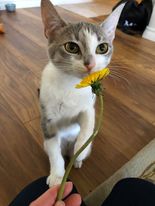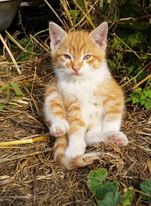
When acquiring a cat, one is faced with decisions regarding vaccines, spay/neuter surgery, and declawing. Declawing is a procedure that has become controversial in the vet industry and is being reconsidered. In fact, some provinces have banned this procedure and many vet clinics will no longer offer this service.
Research indicates that declawing has negative side effects on the physical health and behaviour of cats. The impacts on physical health are both short-term and long-term. Whereas the behavioural implications are inappropriate elimination (urinating or defecating around the house) and unprovoked aggression which can be long-term.
It is important to note that declawing has been a common practice for many years. It has been considered as “one of the things you do” as a pet owner. For that reason, do not feel as though you are at fault if your cat is declawed. This article is meant to provide knowledge to make different decisions in the future.
Find our reasons not to declaw your cat below!
Table of Contents
What is Declawing?
Declawing is a surgical procedure that amputates all or part of a cat’s toe bones (third phalanges) and claws. Typically, this surgery is performed on only the front paws, but in some cases all four paws.
Why Do People Declaw Their Cats?
The main reason for declawing is that it is convenient for the pet owner. This is because they do not have to do nail trims or train their cat not to scratch their furniture. In some cases, it is done for other reasons, but convenience is the most common. Many pet owners are unaware of the implications, and as such, they make an ill-informed decision which they are not to blame for. Perhaps upon having more information, the procedure may be reconsidered.
Why You Should Not Declaw Your Cat

- Causes physical pain- long-term and short-term
- Can cause unprovoked aggression
- Can lead to urinating and defecating outside of their litter box
- Involves amputation of a bone- not just the claw
- Inhibits their natural behaviour
Physical Pain
“Clinical signs of pain following declawing include a ‘guarding’ posture, reluctance to bear weight on the declawed limb(s), and reluctance to move.”
-American Veterinary Medical Association (AVMA)
After declawing a cat experiences pain as stated, “Clinical signs of pain following declawing include a ‘guarding’ posture, reluctance to bear weight on the declawed limb(s), and reluctance to move.” (AVMA). This shows that cats don’t want to use their paws as they naturally would following declawing, due to pain.
Similarly, chronic pain does arise as well, as stated, “Pain and behavioural problems secondary to pain may arise within days to years after declawing” (Gaynor). This is because the removal of their claws prevents them from doing natural tasks such as placing their claws in a scratching post to stretch. It also causes them to place their paw on the ground differently than they normally would. Both of these can cause pain in their shoulders, limbs, and torso causing muscle weakness and pain.
Behavioural Changes & Inhibition
The inability of a cat to place its claws in a surface not only hinders them physically but behaviourally too. Instinctually their claws are used to climb and jump. Being declawed restricts this natural behavior causing distress. This can cause the development of undesired behaviour(s) such as inappropriate elimination and unprovoked aggression. Research indicates that cats that are declawed are three times more likely to urinate and/or defecate around the house. Another undesired behaviour that can arise is biting. A cat’s primary defence mechanism is swatting and scratching their perceived threat, forcing their opponent, human or non-human, to back away. Declawing renders them unable to scratch their opponent so they have to resort to their more extreme defence mechanism of biting (Gerard et al, 638).
This is harmful to both the pet owners and the pet. Unfortunately, this harms the relationship between pet owner and pet because it leads pet owners to believe that their cat has an attitude. But oftentimes a change in behaviour is a coping strategy for dealing with pain. This misunderstanding between pet owner and the pet can lead to the pet being placed in a shelter, or worse- euthanized.
Declawing Alternatives
There are many alternatives to declawing your cat, find our recommendations below!
1) Cat Scratching Posts
These can be placed around your house to provide an appropriate place for your cat to scratch. Scratching posts provide your cat with the ability to stretch its body and sharpen its claws. The post should be tall and sturdy to allow your cat to reach up to use it. This can help deter your cat from scratching your furniture.
2) Feliscratch
Feliscratch is an award-winning and veterinary recommended pheromone product. It is manufactured by a very well-known company in the veterinary industry called Feliway. It is a liquid that can be applied to a scratching post to promote the use of the post instead of your furniture. Feliscratch works by providing visual stimulus of “scratching lines” along the post and utilizes pheromones to convince your cat to use the post. It is very simple to apply! Each package comes with multiple doses in separate pipettes. It is recommended to apply it to the scratching post once per day for 7 days, then once per day for one day on weeks 3 and 4. Repeat as necessary. If you don’t like this product- the company also offers a money-back guarantee! So there is nothing to lose and everything to gain by giving this product a try.
Works for more than 9/10 newly adopted cats/kitten.
-Feliway
3) Soft Paws
Soft paws are nail caps for your cat’s nails! These were invented by a veterinarian and really work! They prevent your cat from being able to scratch your furniture by providing a physical barrier. The important part is, they are still able to retract and use their claws so their natural behaviour is not inhibited! Moreover, they are not painful as most cats don’t even realize they have them on! They are simple to apply but will require 2 people- one to hold and one to apply. Pet safe adhesive is used to adhere the nail caps to their nails. These can last on their nails for a few weeks! If you’re not comfortable applying these yourself many vet clinics will provide this service for a fee.
4) Furniture Tape
The purpose of furniture tape is to deter your cat from scratching your furniture. The sticky surface is not something that cats enjoy so this will stop them from using your couch as a scratching post! Furniture tape comes in different colours, even transparent, and numerous sizes! It is non-toxic so it is 100% pet safe!
5) Cat Trees
Having a cat tree can be beneficial in many ways. Cat trees provide physical activity for your cat as they can run up and down and play on them. It also provides mental stimulation by allowing them to perch atop the tree! Most cat trees are made out of a carpet-like material that cats love to stretch and scratch their claws on too! Many even have a built-in scratching post. This is perfect for guiding your cat to scratch the tree instead of the furniture.
6) Nail Trims
Routine nail trims are key for the maintenance of your cat’s nails. If you are able to you can certainly do this at home using cat nail clippers. Consider reaching out to your vet clinic if you aren’t comfortable with trimming your cat’s nails or if you have a wiggly cat! Trimming their nails helps reduce the sharpness of their nails, meaning less wear and tear on anything that their nails come in contact with. Moreover, it can prevent your cat from getting stuck in the carpet or rugs. It is also important to maintain nail trims because their nails can grow long enough to grow into their pads, causing discomfort and potentially infection.
Frequently Asked Questions
While declawing is done under anesthesia and pain medication is provided after surgery it causes pain and discomfort long term. It is not beneficial to the cat to be declawed.
Declawing cats is done for convenience of the pet owner. This is because then the cat will not be able to scratch their furniture, as mentioned above.
There are many alternatives to declawing a cat. Some are scratching posts, cat trees, soft paws nail covers, regular nail trims, furniture tape, etc. As listed above.
References:
- Gaynor, J. “Chronic pain syndrome of feline onychectomy.” NAVC Clinician’s Brief. (2005): 11-13.
- Literature review on the welfare implications of declawing of domestic cats. American Veterinary Medical Association. (2016): 1-9.
